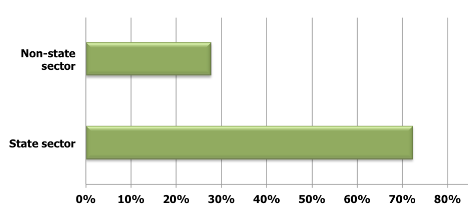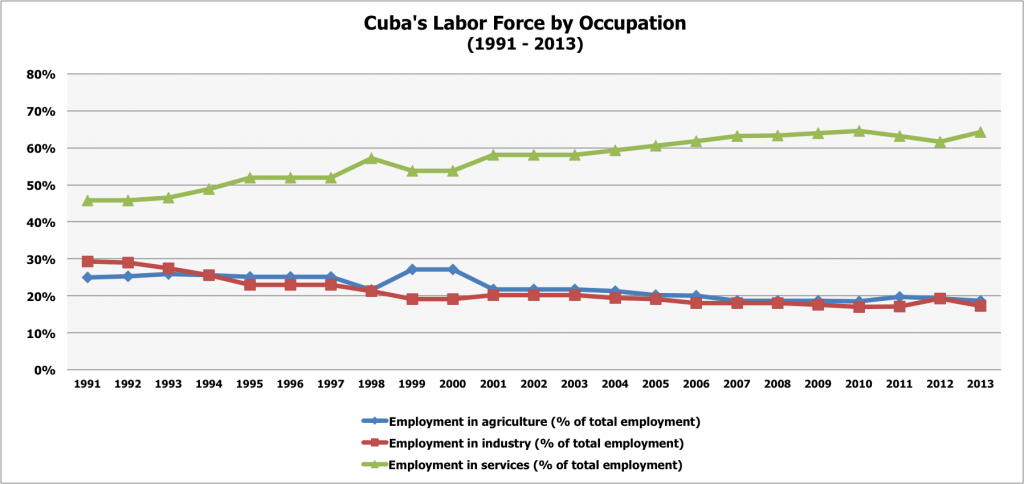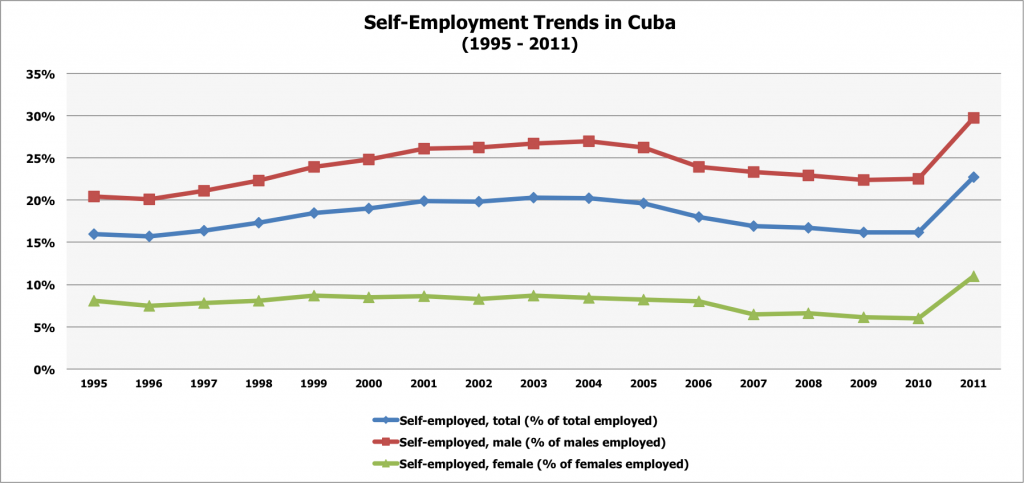Fast Facts:
Total Population: 11,031,433 (July 2015)
World Ranking: 80
Total Labor Force: 5,111,000
World Ranking: 80
Average Wages (2014):
– Monthly: 584 Cuban Pesos ($22 USD)
– Annual: 7,008 Cuban Pesos ($264 USD)
Labor Force by Sectors & Occupations:
Labor Force by Sector (2015 Estimates):
– State sector: 72.3%
– Non-state sector: 27.7%
As of 2015, there were approximately 5.11 million individuals participating in Cuba’s labor force. Almost three quarters of the labor force is employed by the Cuban government, while the remaining quarter is employed by the “private” or non-state sector. This composition clearly shows that despite beginning to allow entrepreneurship and small business ownership, the Cuban government is still by far the nation’s largest employer and undoubtedly still has at least somewhat of a presence in all of the nation’s industries.
Labor Force by Occupation (2013 Estimates):
– Services: 72%
– Agriculture: 18%
– Industry: 10%
The Cuban labor force falls into three primary occupations by sector. The services sector, which includes all economic activities that do not produce material goods, employs almost three quarters (72%) of the total labor force. The agricultural sector, which consists of farming, fishing, and forestry activities, employs 18% of the labor force. The industry sector, which includes manufacturing, construction, and energy production/mining activities, employs the smallest amount of the labor force (10%). The percentage of the total workforce employed by the services sector has slowly, yet steadily increased since the early 1990s (which is as far back as the data goes), while the percentages of the total workforce employed by the agricultural and industrial sectors have slowly and steadily decreased at very similar rates during the same time period.

The figures above show that Cuba is primarily a services-based economy, which is largely attributable to the “services” sector including all government activities and all government-created jobs. However, we believe that Cuba’s employment levels in the agricultural and industrial occupations are currently deflated and will be increasing in the near-term. Since the Cuban Revolution ended in the mid-1950s, the government has not invested in preserving or building up its physical capital, which has deflated employment levels in the industry sector. As tourism increases and as a middle class begins to emerge, Cuba will need to make substantial investments into its existing physical infrastructure and new construction as the demand for roadways, new homes, hotel rooms, restaurants, and etc. booms. In turn, this will also cause energy demand to increase, which will drive the mining and energy production sectors. Furthermore, increased industrial activities combined with improved trading relationships, will also cause the agricultural sector to grow and to become a larger employer. Specifically, as the demand for Cuban agricultural products and exports grow, farms throughout the country will need more agricultural workers.
The Rise in Self-Employment:
Self-employment figures for the Cuban labor force date back as far as 1995 and as most recently as 2011. From 1995 to 2010, self-employment as a percentage of the total employed workforce remained around 16% with a small peak of 20.3% in 2003. The self-employment rate among employed men fluctuated between 20.4% (1995) and 22.5% (2010), while the self-employment rate among women was lower at 8.1% (1995) and 6.0% (2010). However, self-employment levels for both genders significantly increased from 2010 to 2011 reaching 29.7% for men and 11.0% for women.

The increase from 2010 to 2011 clearly shows that the 2011 economic forms, which began permitting limited self-employment in specific retail industries, had an enormous effect during its first year. From a potential investor’s perspective, this shows that the Cuban labor force is interested in pursuing self-employment opportunities and indicates that retail and services industries are adequately staffed and positioned for strong growth. Moreover, self-employed individuals represent a consumer base that may need services like banking, transportation, the internet and telecommunications in order to operate their small businesses or entrepreneurial endeavors. Additionally, if self-employment proves to be successful and/or easy to enter into, then this may lead many Cuban residents (who might currently be unemployed or underemployed) to open small businesses or seek employment as entrepreneurs. In turn, this would add new consumers and more discretionary income into Cuba’s marketplace.
How much do Cuban jobs pay?
Average Wages (2014):
– Monthly: 584 Cuban Pesos ($22 USD)
– Annual: 7,008 Cuban Pesos ($264 USD)
Current exchange rate for CUP/USD: 26.5 CUP = $1USD
Per official employment and wage figures released by Cuba’s National Bureau of Statistics and Information (ONEI), the average monthly wages of the typical Cuban worker steady grew from 466 Cuban Pesos (CUP) in 2012 to approximately 584 CUP by 2014 (or, from $17.55 USD to $22 USD). This means that the average Cuban worker earned an annual salary of 7,008 CUP or $264 USD in 2014.
The 2012 to 2014 wage increases are part of a larger trend. Over the eight-year period spanning 2006 to 2014, the Cuban government incrementally increased wages for state-sector employees each year. As a result of the annual wage increases, the average monthly wage for Cuban government employees (who form almost three quarters of the total labor force) grew by 51.7% from 385 CUP ($14.50 USD) in 2006 to 584 CUP ($22 USD) in 2014. Although wages are still low, the Cuban government has pointed out that “basic services” like education and healthcare are free for all Cubans despite arguably being two of the most expensive services in any country.
Raul Castro has also declared that future wage increases will be contingent upon achieving higher levels of national productively. For example, in 2014 the government significantly increased wages for healthcare workers to reflect the fact that exporting healthcare services to other countries generates $6.0 billion annually and is Cuba’s largest income stream. As potential investors, we believe that tying wage increases to productivity levels will increase productivity, profitability, and spur economic growth.
Immigration & Emigration:
When wages increase in a country, immigration into that country frequently increases as well because individuals want to join its labor force in order to capture higher wages. While this is a general macroeconomic principle that typically holds true for developed nations like the United States or Canada, Cuba’s steadily increasing raises are nowhere near a level that would increase immigration into the country. Moreover, if Cuba’s increasing wages did result in increased immigration, the Cuban government’s extremely tight control over wage levels would prevent wages from being driven down due to more candidates fighting for each open job.
However, we believe that Cuba’s steadily increasing wages is one of the primary factors that can effectively lower the nation’s emigration rate and prevent its population from shrinking. By raising wages, the Cuban government is providing an economic incentive for Cuban citizens to remain in the country. If successful, then this approach will cause Cuba’s labor force to grow and will result in an outward shift in the labor supply; while theoretically this would decrease wages, since the Cuban government controls wages, this would not happen. And even it if does, with the potential for a huge tourism boom in the near future, there would be an increase in demand for workers of all levels, ranging from low-skilled in construction, for example, to high-skilled in management related positions. Thus, the labor demand curve would shift right and raise the wages, arriving at equilibrium. Over the long term, this is a positive scenario for Cuba.
Outsourcing & Offshoring:
When wages increase in a country, businesses within the country often look at outsourcing or offshoring jobs as a way to lower costs and avoid paying higher wages. While this is a common macroeconomic principle, it is one that does not hold true for Cuba. Raul Castro’s government is controlling and intentionally increasing wages in order to spur economic growth and to combat emigration. Moreover, the Cuban government employs almost 75% of the nation’s labor force and would not outsource jobs to avoid its own wage policies!
From our analysis thus far, we believe that Cuba could actually benefit from “reverse” outsourcing and offshoring (other countries outsourcing or offshoring to Cuba). As discussed on other pages, Cuba has an extremely literate population, an under-utilized human capital level, low overall wage levels, is within easy shipping proximity to many potential trading partners, and has been improving diplomatic relationships with the United States. A combination of these factors could lead other countries (that have higher domestic labor and production costs than Cuba’s) to view outsourcing/offshoring to Cuba as a viable business decision and cost-savings strategy.
Sources:
The CIA World Factbook
The World Bank – World Development Indicators
XE – The World’s Trusted Currency Authority
Cuba’s National Bureau of Statistics and Information (ONEI)
Fox News Latino
